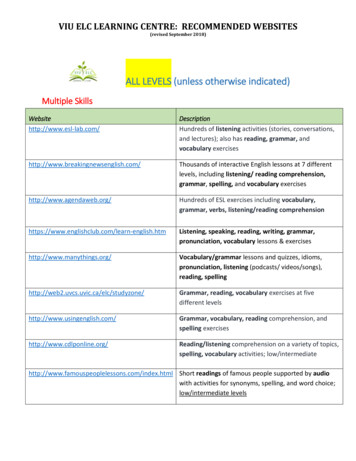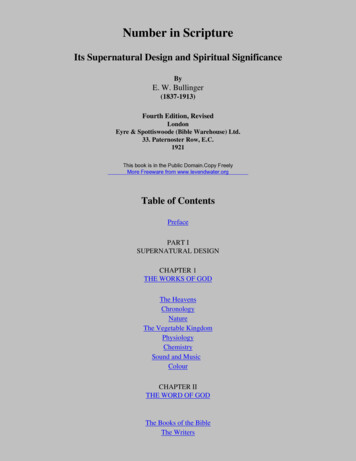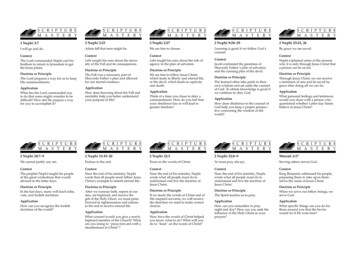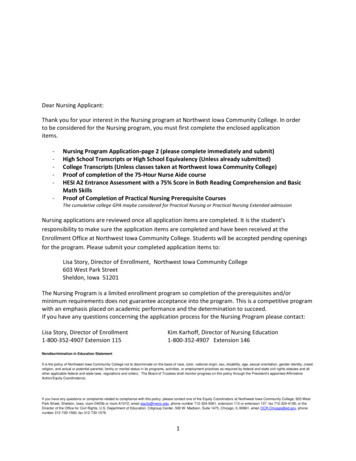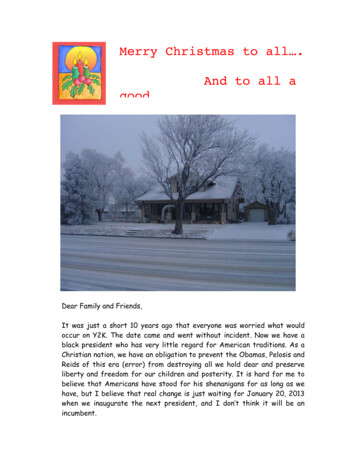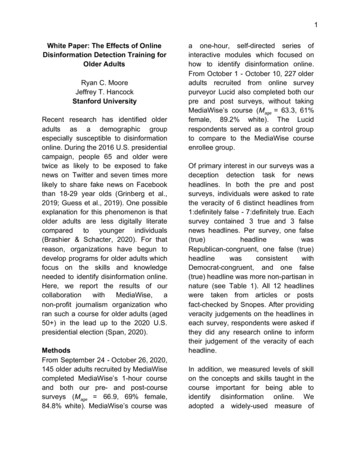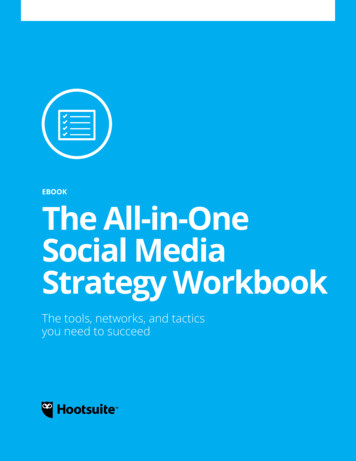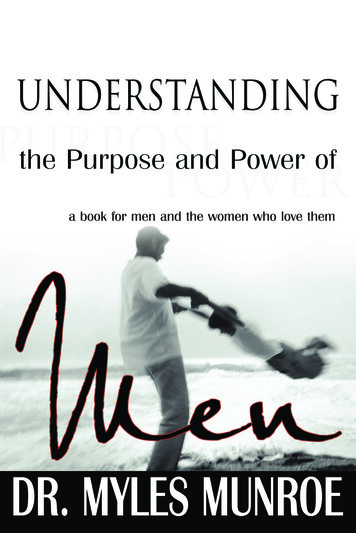
Transcription
Unless otherwise indicated, all Scripture quotations are from the Holy Bible,New International Version , NIV , 1973, 1978, 1984 by the InternationalBible Society. Used by permission of Zondervan. All rights reserved. AllScripture quotations marked (NKJV) are from the New King James Version, 1979, 1980, 1982, 1984 by Thomas Nelson, Inc. Used by permission. Allrights reserved. Scripture quotations marked (KJV) are from the King JamesVersion of the Holy Bible. Scripture quotations marked (NASB) are from theNew American Standard Bible , NASB , 1960, 1962, 1963, 1968, 1971,1972, 1973, 1975, 1977, 1988 by The Lockman Foundation. Used bypermission. (www.Lockman.org)UNDERSTANDING THE PURPOSE AND POWER OF MENa book for men and the women who love themDr. Myles MunroeBahamas Faith Ministries InternationalP.O. Box N9583Nassau, Bahamase-mail: bfmadmin@bfmmm.comwebsites: www.bfmmm.com; www.bfmi.tv; www.mylesmunroe.tvISBN-13: 978-0-88368-725-3ISBN-10: 0-88368-725-9Printed in the United States of America 2001 by Dr. Myles MunroeWhitaker House1030 Hunt Valley CircleNew Kensington, PA 15068www.whitakerhouse.comLibrary of Congress Cataloging-in-Publication DataMunroe, Myles.Understanding the purpose and power of men / by Myles Munroe.p. cm.ISBN 0-88368-725-9 (pbk. : alk. paper)1. Men (Christian theology) 2. Sex role—Religiousaspects—Christianity. I. Title.BT703.5 .M86 2002261.8'3431—dc212001007727No part of this book may be reproduced or transmitted in any form or by anymeans, electronic or mechanical—including photocopying, recording, or by anyinformation storage and retrieval system—without permission in writing from thepublisher. Please direct your inquiries to permissionseditor@whitakerhouse.com.7 8 9 10 11 12 13 14 15 1617 16 15 14 13 12 11 10 09
DedicationTo my beloved son, Chairo, with a hope that the contentand principles of this book will become the quality of yourcharacter and the story of your life.To Paul, forever my brother in this life and the next. Mayyour memory live on through the things you taught me as areal male-man.To my beloved dad, Matt Munroe—my male mentor.To the men of BFM Fellowship‘s Real Men Ministry—yourpassion for truth inspires.To males of every race, culture, creed, and nation in yourstruggle to discover and master the mystery of being a man.To the Third-World man in his pursuit to recover hislost identity.To the Manufacturer of the man and the male.
AcknowledgmentsOur natural conception and birth is a result of humancooperation and established the priority the Creatorplaces on our dependency on others for success and personal progress. This work is a testimony to this cooperationand confirms the reality that we are a sum total of all thecontributions made to our lives by the people we have hadthe privilege to encounter on the journey of life. I am deeplygrateful for the inspiration and wisdom of the men andwomen, both past and present, who, through their lives,instructions, corrections, challenges, commitment, and example, stirred gifts within me that I did not know I had.I am also grateful to all the friends and colleagues of theInternational Third World Leaders Association who continueto inspire me to make a contribution to my generation andthose to come.For the development and production of this book itself,I feel a deep sense of gratitude to:My precious wife, Ruth, and our children, Charisa andChairo (Myles, Jr.), for their patience and support during my globe-trotting duties. Being your husband andfather tested the reality of the principles in this bookand has made me a real male-man. I love you all.Lois Smith Puglisi, diligent and gifted editor and advisor, who shepherded this book from conception to itspresent form. You are a gift to any author, and mayyour gift continue to make a way for you in the world.Jim Rill, for believing in me and the value of this message while patiently pursuing me to keep to the schedule and meet deadlines in completing this work.
ContentsPreface . 8Introduction . 101. What Is a Real Man? . 172. Seven Principles of Purpose . 373. The Creation of Man. . 574. God’s Purpose for the Male. . 715. Dominion versus Domination . 996. The Male as Visionary and Leader . 1177. The Male as Teacher and Cultivator . 1328. The Male as Provider and Protector.1499. A Man and His Sex Life . 16510. Male-Female Differences . 18511. How to Be a Good Father . 19812. Keys to Becoming a Real Man . 213A Word to Men of Third-World Nations. 220About the Author . 222
PrefaceThe twenty-first century male is in crisis. Throughout thenations of our global village, the prisons are filled withmultitudes of men. Compared to their counterpart, women,they are responsible for a vast majority of the criminal behavior worldwide. They are also victims of drug abuse and theprincipal carriers of the dreaded AIDS virus. Many havefound a home in subculture gangs, instigating antisocial activities that wreak havoc on the social order. Men revel in theoppression of women and perpetuate domestic violence.In every culture and social system, men are struggling tofind their place in a fast-changing world. In many societies,the dramatic change in the status of women, the workplace,and traditional cultural roles has left a significant number ofmen confused, disillusioned, angry, frustrated, and traumatized. Yes, the male of this cyber-technical, Internet-driven,postmodern world is caught in a worldwide web of confusion.Men are in trouble but are afraid to admit it. They are lost ina maze of new paradigms and the uncharted waters of socialand cultural convergence.Change is often the source of uncertainty and a measureof fear and anxiety. For many, this type of fear is difficult tomanage, and it causes varying reactions. Some negativereactions to change include denial, ignorance, isolation, anger, resistance, and resentment. These reactions can causeserious effects on the environment in which the change istaking place. The result can be oppression, suppression, violence, and the spirit of control.A brief study of the behavior of the male-factor in manynations today, including yours, will reveal such reactions tocultural changes. The drastic transitions taking place in social structures and the shifting of long-held beliefs are destroying the defining lines and the very definitions of ourlives. For the male in most societies and cultures, this redefinition is traumatic and has rendered many men without aclear definition of manhood, masculinity, and fatherhood.8
PrefaceThe impact of the confusion on women, the family, andsociety is also frightening. Many women suffer the violence ofangry men. Children are victims of abuse and resentment,and society bears the scars of social deterioration. Governments are helpless to respond to this phenomenon. Theyfind their ideas, laws, and social programs ineffective in addressing it. Men are clearly in trouble.So what is a man to do? The number one challenge tothe male is his identity crisis. The average man is confusedabout his manhood, masculinity, and sexuality. He doesn‘thave a clear definition of what a man is supposed to be.Some men have confused their cultural, social, and traditional roles with the definition of manhood. However, thishas proven to be one of the major causes of the problem because, as the roles change, so does a man‘s image of himself.How do we measure a man? What is true manhood?How do you define masculinity? What is true male sexuality? What is the true purpose of the male in relation to thefemale? Is there a universal definition of manhood? Can itbe attained? Where do we go to get this definition?This book addresses answers to these critical questionsfrom the perspective of the male. The purpose and role ofthe male in the scheme of human experience is exploredthrough returning to the original process of his creation,based on the premise that no one knows the product likethe manufacturer. No product can understand its identityby asking the customer, because only the manufacturerknows the original purpose and potential of his product.Therefore, it is imperative that the male rediscover his original purpose and understand his true potential, as well asgain a clear understanding of his principal function withinthe human family.The male is the key to building strong, enduring socialinfrastructures, stable families, sane societies, and securenations. It is critical that the subject of the male‘s crisis bea priority for men, women, and national governments, sothat we can secure progressive social developments withinthe countries of the world. Let us begin our journey throughthe land of cultural confusion to rediscover the purpose andpower of the real male.9
IntroductionThe male holds the key to the nations—and our nationsare in crisis. As the man goes, so goes the family, society, and the world. The problem is, men don‘t have aclear idea of where they‘re going anymore. They are sufferingfrom a lost sense of identity—and the consequences for theirfamilies, communities, and nations are far-reaching.Conflicting Views of ManhoodTraditional male roles once gave men continuity andbalance from generation to generation.Today, many men are questioning whoMales arethey are and what roles they are tosuffering aplay in life. On the surface, they maylost sensebe following customary life pursuits,of identity.such as working, marrying, and having a family. Yet they have an inner uncertainty about whatit means to be a man, a husband, and a father.What is causing this uncertainty? A major reason is thatsociety is sending out conflicting signals about what itmeans to be a man. Traditional views of masculinity competeside by side with new ideas of manhood in the marketplaceof ideas—each vying for supremacy.A Clash of Old and New IdeasThis contest of ideas is being played out as we absorbthe vast social and political changes that have taken placeover the last forty years. On both national and internationallevels, cultures and ideas are colliding. As a result, peopleare reevaluating what it means to be human, what it meansto be a man or a woman, and what it means to be a country.Some of these developments are:10
Introduction the movement for women‘s equality,the exportation of Western culture in the world,the fall of Communism,the global marketplace,a growing interconnectedness between nations.Whether worldwide or locally, our world is rapidlychanging before our eyes, and the social transformation accompanying it can often be painful. The clash of old andnew ideas has left many men perplexed and frustrated inregard to their identity. How do their new roles (for example, equal partnership with women) play out against moretraditional ones (such as breadwinner and protector)? Menare feeling compelled to redefine their roles as they attemptto adapt to these changing social expectations. This adjustment is disrupting both their professional and personallives. It is altering their relationships with women. It istransforming family life.Yet the lines of these new roles look blurry to men astraditional and contemporary ideas eclipse—overshadowingone another—and then separate again. For example, on theone hand, men are told there is no real difference betweenmales and females and that they are to consider women asequals. On the other hand, they are encouraged to treatwomen with special care and courtesy—but when they do,they are often accused of chauvinism.The Male in CrisisHistorically, men have defined their manhood by thevarious roles they have fulfilled for their families and for society. Now that these roles are in transition, they don‘t havea solid definition of masculinity to give them a cultural context for life. As a result, many men believe they have lostpart of themselves, but they don‘t have anything concretewith which to replace it. Often, they don‘t even feel wantedor needed by women any longer. They used to have cleardirection about where they were going as men. Now, it‘s asif they‘re trapped in a maze, frustrated and unable to moveforward purposefully in life.11
Understanding the Purpose and Power of MenSome men have reacted angrily against the women‘smovement and other social changes. They have no intentionof adapting. Instead, they have reMen haveasserted or tightened their traditionaldefined theirdominance over women because they aremanhood byafraid of losing control. They havereacted by being either competitive ortheir roles.isolationist. They are domineering oreven abusive to their families. In certain countries, men haveaggressively fought back on a national level. They have countered the advancement of women‘s equality with severe restrictions on the lifestyle and freedoms of women becausethey perceive these changes to be part of the Westernizationof their societies—a moral corruption that is harming theirway of life.A Crucial CrossroadsWhy is the male‘s crisis of purpose such a pivotal issue?For one thing, it attacks the core of who men are, leavingthem indecisive and foundationally weak. For another, it reflects a breakdown in understanding, communication, andcooperation between men and women that is unnatural andunhealthy. Males are at a crucial crossroads, and where theygo from here will have a serious effect on the course of society. The crisis of purpose they are experiencing will escalate ifthey continue to live in an uncertain or defensive state ofmind. They will remain frustrated and will live at a level farbelow their potential. Moreover, the cracks in the foundationof society will grow dangerously wider.What should men do? Should they hold on to traditionalroles and ways of thinking, or should they follow the roadbeing paved by new concepts of maleness?It would be difficult to stop the flow of change, and wewould not want to return to tradition merely for the sake oftradition. The old system did not reflect the full purpose andpotential of men, and women were often devalued under it.Yet contemporary concepts of maleness are often ambiguous. They also tend to focus on roles rather than on the12
Introductionmale‘s underlying purpose and identity (a crucial distinctionthat this book explores). What kind of world will we have ifwe keep following this new path? We already have some ideaof the negative effects that a continuing male crisis of purpose would bring. Many of our current social problems, suchas teenage pregnancy, crime, and poverty, flow from purposelessness and rootlessness among men.The majority of crimes worldwide are committed bymen. Ninety to ninety-five percent of those in prison in theUnited States are males. Recently, I have been amazed atthe increasing numbers of boys who are involved in crime.We are seeing more and more criminal activity by males between the ages of nine and eighteen. In London, a five-yearold boy was murdered by an eleven-year-old boy. In Chicago, a six-year-old girl was murdered by a nine-year-old boy.I remember when criminals used to be old men.How often do you see a list of crimes that were committed during a given week in which 50 percent of the culpritswere women? Never. It‘s really a male issue.Whether we‘re talking about a broken home, an abusedwife, an abandoned child, or a crime, we are looking primarily at a male problem that stems from a misguided purpose or a lack of true identity.The Issue Is Purpose, Not MalenessWhy are many social ills caused by men? It may betempting for some to dismiss males as hopelessly aggressiveand domineering, with an essential nature in need of anoverhaul. I‘d like to present an alternative perspective: theproblem is not a biological one of maleness—but a spiritualone of identity. Male identity is not essentially a matter ofroles, which vary with culture and shift with changingtimes—it is a matter of inherent purpose.Therefore, to address the problems of our society and theworld, we must start with the male and how he perceiveshimself. If men knew who they really are and their true reason for being, then their confusion, anger, and destructivebehavior could be replaced with purposefulness, confidence,13
Understanding the Purpose and Power of Menand a building up of society. It‘s when men don‘t know whothey are and what purpose they have in this world that weexperience a myriad of cultural problems.While society is feeling the effects of the male‘s dilemma,it is also apparently contributing to it by presenting incomplete or confusing ideas of manhood. In this way, society isunknowingly bringing trouble upon itself. This double-edgedsword is not new to our generation or our world.The Consequences of Ignorance of PurposeThe crisis we are seeing today is actually a contemporary version of an age-old dilemma. Men and women alikelost their concept of what it truly means to be human—male and female—a long time ago. The problem is also notconfined to particular cultures. The question of identity is aglobal problem. I have traveled to many nations, and I haveconcluded that most of the world is suffering from what Icall the ―consequences of ignorance of purpose.‖ In everynation, in every community, no matter what language thecitizens speak or what color their skin is, people are experiencing a common dilemma. They are suffering the debilitating effects of a misconception of purpose. They don‘tunderstand who they really are and therefore aren‘t livingup to their full potential in life.In my earlier book, Understanding the Purpose andPower of Woman, I showed how humanity‘s ignorance ofpurpose has historically degraded women. (I recommendthat book to men, just as I recommend this one to women.)I talked about how we can alleviate the pain and unfulfilledpotential this misunderstanding of purpose has causedwomen over the centuries so they can be free to become allthey were meant to be.However, neither males nor females will ever be fully actualized if the crisis of the male is not addressed, since menhave a primary influence on the tone and direction of society.This influence is meant to be used for good. However, as wesaw in regard to many of the social problems we are facing, itcan have exactly the opposite effect if it‘s not understood or if14
Introductionit‘s abused. There is no way that we can have a safe andproductive world as long as humanity as a whole doesn‘tknow its reason for existence—and men in particular don‘thave a clear idea of their identity.People can go for years without realizing they aren‘t fulfilling their true purpose. Both individuals and cultures canbecome comfortable following established roles withoutquestioning their validity. HowevOur crisis ofer, our socially turbulent societyidentity is ais forcing us to examine the unpowerfulderlying foundation of our conceptsofmalenessandopportunity forfemaleness. In this sense, we canfindinglook at this crisis as a powerfultrue purpose.opportunity for self-discovery andself-actualization. It is up to us to make accurate tests ofthe soundness of both traditional and contemporary ideasof what it means to be male and female, and then to relay astrong foundation for society.The purpose of this book is to give us principles formaking that assessment and fulfilling our true purpose ashuman beings.A Rediscovery of PurposeTherefore, to rediscover the masculine identity, we needto address these questions: How can men gain their footing in the ever-shifting environment of cultural expectations?What does it mean to be male?What definition of masculinity should men adopt?Why is a male‘s self-concept so important to the foundation of society?What roles should men fulfill—in the workplace and inthe home?What do gender roles have to do with the male‘s purpose?15
Understanding the Purpose and Power of Men What are the differences between males and females?How are men and women meant to relate to one another?How can a man build a better life for himself, his family, and the world?In the following pages, I will explore these questions ina very straightforward and practical way. Join me for a rediscovery of purpose: the man as he was meant to be.16
1What Is a Real Man?Men Need a God-Given Identity if They Are toFulfill Their True Purpose.Imagine that you are watching a television show similarto To Tell the Truth. Several contestants try to convinceyou that they are the Real Man. You have to guesswhich one is authentic and which ones are the imposters.Contestant #1 tells you he is the Real Man because hefills the traditional male role: he supports his family financially while his wife cares for the children and the home. Aslong as he provides a roof over their heads and food forthem to eat, he‘s fulfilling his duty as a husband and father. This man doesn‘t consider his wife to be his trueequal.Contestant #2 says he is the Real Man because he has aculturally progressive role: he shares household and childrearing responsibilities with his wife while they both pursuecareers. He thinks of his wife as his equal.Contestant #3 explains that he is the Real Man becausehe has been freed from male stereotypes and has decided totake on the nurturer role of caring for the children and homewhile his wife goes to work. He considers his wife equal tohimself—or maybe even better, since she has a more compassionate, sensitive nature than he does.These are some of the images of manhood that are competing for men‘s acceptance today. Many men feel as ifthey‘re being asked to guess what a real man is by determining which ―contestant‖ has the most convincing facial expressions and answers. Yet there seems to be no clear-cut17
Understanding the Purpose and Power of Menwinner. In addition, society keeps mixing and matchingthese images until men don‘t know what‘s expected of themanymore. They are confused and frustrated as they try tosort through their own expectations for manhood while feeling pressure from the various segments of society that arepromoting these images—or an impossible combination ofthem. Meanwhile, Hollywood is flooding society with intriguing icons of masculinity, such as James Bond and Rambo.Even though these images are superheroes rather than realmen, it‘s sometimes hard to escape their allure. It‘s difficultnot to start thinking that a real man should somehow imitate the power and resourcefulness they exhibit.A Crisis of RolesWhat makes our current cultural situation unsettling formen is that males have traditionally defined their manhoodby their roles: the functions they perform for their familiesand in society. However, there‘s been amajor shift in the roles of both males andThe rolesfemales. The rules of society are changing.and theThis has happened just in the last fortyrules ofsociety are years or so. We‘re in the middle of a cultural transition, and competing ideas ofchanging.masculinity are causing perplexing problems for men. They are being pulled in several directions atonce while they try to figure out what it means to be a realman in today‘s world.In recent years, literature focusing on changes in men‘slives has indicated that the male is in a state of crisis andinternal conflict. An array of studies are telling us that malesaren‘t quite sure who they are or what women expect fromthem. Without a clear idea of their identity, men are trying tocope with the collision of new societal expectations and traditional ideas of what a man should be, which they have internalized through family, culture, or natural inclination.Men‘s basic conceptions of manhood are therefore beingdisrupted. They feel displaced. They are either frustrated andstruggling to adapt to a new but vague concept of who theyare, or they‘re angry and trying to reverse the flow of change.18
What Is a Real Man?Are traditional roles to be totally abandoned? If so,what will replace them? Many men have unanswered questions, such as these:1. Is a man still supposed to be the breadwinner and protector? Today, the woman goes out and makes her ownbread and says she doesn‘t need protection. A man isn‘tsure what he‘s supposed to do for a woman anymore.2. Is a man still the leader and authority in the home? Thisisn‘t clear anymore. The woman says, ―You‘re not myauthority. I‘m not a slave. I make my own money andmy own decisions. I do what I want to. I‘ll call you whenI‘m ready for you.‖ A man doesn‘t know how he‘s supposed to relate to a woman any longer.3. Should a man still show chivalry? Should he open thedoor for a woman, escort her, pay for her meal on adate, and so on? A man will pull out a chair for a woman and she‘ll say, ―That‘s all right. Thank you verymuch, but I‘ll pull my own chair out.‖ Sometimes a manwill open a door for a woman and she‘ll be offended. ―Doyou think I‘m crippled?‖ she‘ll demand. If a womanwalks into a room and a man stands up out of respect,she might look at him as if he‘s crazy. A man isn‘t sure ifhe should be nice to a woman anymore.4. Is a man still the defender of his family, property, andcountry? More women are entering law enforcement andthe armed forces and are carrying guns. Some men don‘tknow how to react to these changes. A woman walks intothe house with her uniform on and her husband isscared to say hello to her. He‘ll jump up and say, ―Sergeant!‖ Many men are thinking, ―She really doesn‘t require me to protect her.‖ Men don‘t know if women evenneed them anymore.Is there anything now that marks a man as differentfrom his female counterpart? Based on the above scenarios,that‘s a difficult question to answer. Males and females arein a state of gender upheaval and confusion.19
Understanding the Purpose and Power of MenSo what do you do in order to be a man in the twentyfirst century? Who are men in relation to women? How aremen to sort out the various versions of masculinity that arebeing promoted in the world?If you are a male and feel that your work, your relationships, and your view of the world are being turned upsidedown, you‘re not alone. This is the most complex time inthe world to be a man. Men of all ages are grappling withcompeting views and values of manhood.What has happened?Thousands of Years of Tradition Set AsideMales used to acquire their ideas of manhood from observing their fathers or from longstanding cultural traditions.There was a continuity of masculineMen and womroles from generation to generation.en hadThings are different now. Hundreds,specific roleseven thousands, of years of traditionthat did nothave been set aside in just one or twogenerations. This shift may have staroverlap.ted in Western and industrialized nations with the women‘s movement and other culturalchanges, but its influence is being felt in one way or anotherall over the world.For example, my life is completely different from my father‘s life. I can‘t use the way my father did things as amodel for myself, and my sisters can‘t use the environmentin which my mother functioned as an example for themselves. Our parents lived not only in a different generation,but also with different concepts of maleness and femaleness. Historically speaking, until recently, the man had certain accepted roles and the woman had certain acceptedroles, and they didn‘t usually overlap.Historical RolesYou can go back fifty, one hundred, five hundred, twothousand, four thousand years, and you‘ll find a fairlyconsistent pattern of roles for men and women that were20
What Is a Real Man?acknowledged and valued. There were some very practicalreasons for this longstanding pattern. There have alwaysbeen certain exceptions to the pattern among individualsand cultures, but the following is the way most familiesconducted themselves for generations. This traditional pattern continues to have an influence on male-female relationships today.There Was a Biological Determination of RolesIn pre-modern times, biology contributed largely to theroles of men and women. Males are generally physicallystronger than women, so the men were the ones who wentout to hunt and provide for the family. Females are biologically equipped to have babies, so they cared for the children. In general, there were no birth control options and noabortion alternatives with which a woman could supersedebiology. A man didn‘t have to wonder whether he or his wifewould stay home and raise the children. Roles were lesscomplicated because they were predetermined by biology.Everyday Living Was a Struggle for SurvivalIn addition, people lived in a more hostile physical environment in which day-to-day living was a struggle for survival. This was another reason why the man, who wasphysically stronger, naturally became the provider and protector of the family.At that time, making a living was an especially precarious job. The man literally had to riskMen had tohis life to take care of his family. Thisrisk theircaused his wife and children to look tolives makinghim for leadership and to value his crua living.cial contribution to their survival. Theydepended on him.When a man went out to get food for his family, therewas no guarantee that he would come back alive. He mightbe fatally wounded by an animal or die of exposure. Therefore, the woman rejoiced to see him come home again. The21
Understanding the Purpose and Power of Mensame basic attitude held true in our parents‘ and grandparents‘ time when most husbands were the sole breadwinnersof their families and their wives stayed at home. In the evening, the whole family was happy that the father had returned. Why? He had been out there in a risky world tryi
Scripture quotations marked (KJV) are from the King James Version of the Holy Bible. Scripture quotations marked (NASB) are from the New American Standard Bible . A brief study of the behavior of the male-factor in many nations
